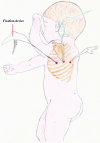Use of Nonabsorbable Spiral Tacks for Mesh Reinforcement in Thoracoscopic Repair of Congenital Diaphragmatic Hernia
- PMID: 29577002
- PMCID: PMC5864520
- DOI: 10.1055/s-0037-1612618
Use of Nonabsorbable Spiral Tacks for Mesh Reinforcement in Thoracoscopic Repair of Congenital Diaphragmatic Hernia
Abstract
Thoracoscopic prosthetic repair of congenital diaphragmatic hernia (CDH) is a well-established and safe technique in experienced hands but the patching procedure is technically demanding and time consuming. To address the challenges associated with this process (confined working space and restricted time), the aim of this article is to assess the potential improvements in feasibility, efficacy, and safety of patch fixation by using nonabsorbable helicoidal tacks in neonates and infants for the repair of large CDH by thoracoscopy. The new technique has all the advantages of minimal invasive surgery in very young children combined with the advantages of reduced operating time and increased simplicity, and may be a good option in cases of recurrence.
Keywords: diaphragmatic hernia; patch; tack; thoracoscopy.
Conflict of interest statement
Figures





Similar articles
-
Thoracoscopic repair of neonatal diaphragmatic hernia.J Laparoendosc Adv Surg Tech A. 2008 Dec;18(6):875-80. doi: 10.1089/lap.2007.0239. J Laparoendosc Adv Surg Tech A. 2008. PMID: 19105674
-
Thoracoscopic repair of congenital diaphragmatic hernia in children.Semin Pediatr Surg. 2007 Nov;16(4):238-44. doi: 10.1053/j.sempedsurg.2007.06.005. Semin Pediatr Surg. 2007. PMID: 17933665
-
Multimedia article. Thoracoscopic patch repair of a right-sided congenital diaphragmatic hernia in a neonate.Surg Endosc. 2009 Jan;23(1):215. doi: 10.1007/s00464-008-0071-1. Epub 2008 Jul 15. Surg Endosc. 2009. PMID: 18626698
-
Mesh fixation techniques in primary ventral or incisional hernia repair.Cochrane Database Syst Rev. 2021 May 28;5(5):CD011563. doi: 10.1002/14651858.CD011563.pub2. Cochrane Database Syst Rev. 2021. PMID: 34046884 Free PMC article.
-
Thoracoscopic Neonatal Congenital Diaphragmatic Hernia Repair: How We Do It.J Laparoendosc Adv Surg Tech A. 2021 Oct;31(10):1168-1174. doi: 10.1089/lap.2021.0420. Epub 2021 Sep 27. J Laparoendosc Adv Surg Tech A. 2021. PMID: 34569855 Review.
Cited by
-
Thoracoscopy in pediatrics: Surgical perspectives.Ann Thorac Med. 2019 Oct-Dec;14(4):239-247. doi: 10.4103/atm.ATM_114_19. Ann Thorac Med. 2019. PMID: 31620207 Free PMC article. Review.
-
Surgical management of the diaphragmatic defect in congenital diaphragmatic hernia: a contemporary review.World J Pediatr Surg. 2024 Aug 21;7(3):e000747. doi: 10.1136/wjps-2023-000747. eCollection 2024. World J Pediatr Surg. 2024. PMID: 39183804 Free PMC article. Review.
References
-
- Vijfhuize S, Deden A C, Costerus S A, Sloots C E, Wijnen R M. Minimal access surgery for repair of congenital diaphragmatic hernia: is it advantageous?--An open review. Eur J Pediatr Surg. 2012;22(05):364–373. - PubMed
-
- Davenport M, Rothenberg S S, Crabbe D C, Wulkan M L. The great debate: open or thoracoscopic repair for oesophageal atresia or diaphragmatic hernia. J Pediatr Surg. 2015;50(02):240–246. - PubMed
-
- Silecchia G, Cavallaro G, Raparelli L, Olmi S, Baldazzi G, Campanile F C. Titanium versus absorbable tacks comparative study (TACS): a multicenter, non-inferiority prospective evaluation during laparoscopic repair of ventral and incisional hernia: study protocol for randomized controlled trial. Trials. 2015;16:249. - PMC - PubMed
Publication types
LinkOut - more resources
Full Text Sources
Other Literature Sources

